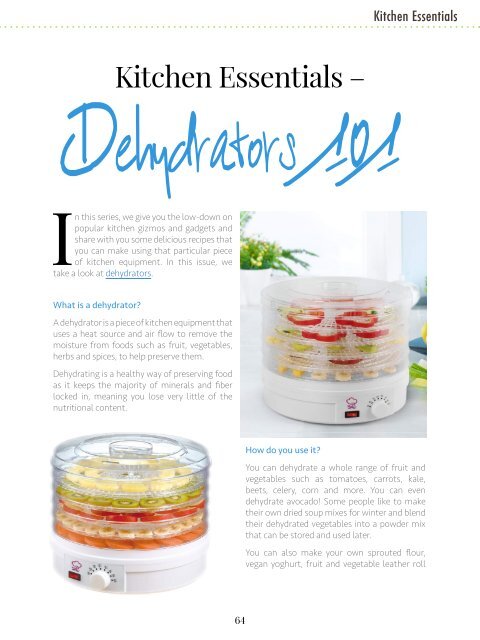One Bite Vegan May 2019
Create successful ePaper yourself
Turn your PDF publications into a flip-book with our unique Google optimized e-Paper software.
Kitchen Essentials<br />
Kitchen Essentials<br />
In this series, we give you the low-down on<br />
popular kitchen gizmos and gadgets and<br />
share with you some delicious recipes that<br />
you can make using that particular piece<br />
of kitchen equipment. In this issue, we<br />
take a look at dehydrators.<br />
What is a dehydrator?<br />
Kitchen Essentials –<br />
Dehydrators 101<br />
A dehydrator is a piece of kitchen equipment that<br />
uses a heat source and air flow to remove the<br />
moisture from foods such as fruit, vegetables,<br />
herbs and spices, to help preserve them.<br />
Dehydrating is a healthy way of preserving food<br />
as it keeps the majority of minerals and fiber<br />
locked in, meaning you lose very little of the<br />
nutritional content.<br />
How do you use it?<br />
You can dehydrate a whole range of fruit and<br />
vegetables such as tomatoes, carrots, kale,<br />
beets, celery, corn and more. You can even<br />
dehydrate avocado! Some people like to make<br />
their own dried soup mixes for winter and blend<br />
their dehydrated vegetables into a powder mix<br />
that can be stored and used later.<br />
You can also make your own sprouted flour,<br />
vegan yoghurt, fruit and vegetable leather roll<br />
ups, jerky, and proof sourdough.<br />
Dried fruit can last up to five years if<br />
properly prepared and stored. Dried<br />
veggies will last even longer; up to ten<br />
years or more!<br />
Depending on the brand that you<br />
choose and what you’re trying to make,<br />
drying produce is as easy as cleaning<br />
and cutting it, placing it on the drying<br />
tray or rack and leaving it in the machine<br />
for a set period of time. Usually the<br />
dehydrator will come with instructions<br />
and have a timer that you can set for<br />
varying lengths of time depending on<br />
the item you’re drying.<br />
A good dehydrator produces a gentle<br />
heat that dries the food slowly and<br />
evenly, preserving the organic matter<br />
and preventing “case hardening” on the outside.<br />
This occurs when the fruit or vegetables are<br />
heated too quickly and a seal forms on the<br />
outside, trapping in moisture.<br />
This will mean that the produce will rot or<br />
harbor bacteria or mold, which is not the result<br />
we’re going for! That’s why it’s so important to<br />
remove as much water as possible.<br />
Which dehydrator is right for me?<br />
If you’re just starting out you can get a very<br />
simple dehydrator at a reasonable price. Simple<br />
models come in many different sizes with<br />
varying numbers of shelves or trays.<br />
You want to make sure that you choose a<br />
brand that dries the food gradually and evenly<br />
to prevent case-hardening as we mentioned<br />
above.<br />
In deciding which one is the best for you, it’s<br />
a great idea to look at all the key features of a<br />
dehydrator to see if they suit your needs. This<br />
includes things like:<br />
• How many drying levels or trays does the<br />
machine have?<br />
• Are trays or mats included for making<br />
fruit and vegetable leathers?<br />
• Is the machine large enough to handle the<br />
amount of food you want to dry?<br />
• How much space do you have to<br />
accommodate the machine – countertop or<br />
storage?<br />
64 65



